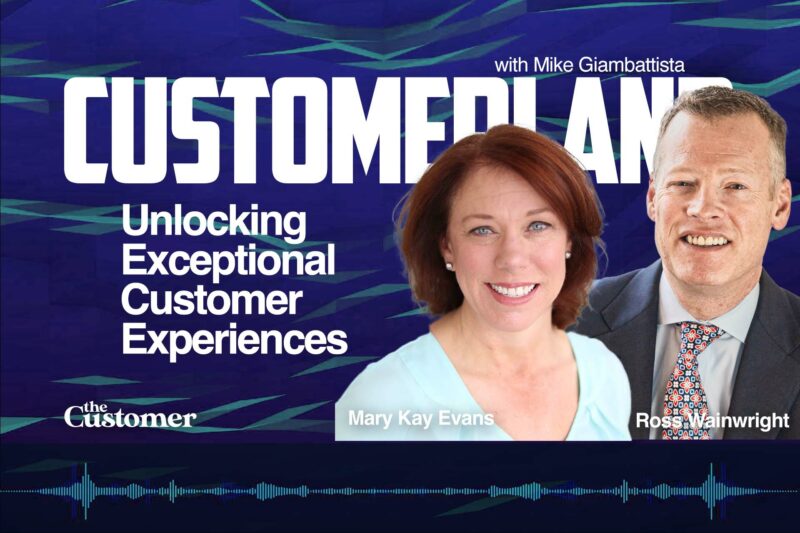Alida’s Emphasis on Company Culture Pays Dividends
What happens when you prioritize company culture and employee experience above all else? Join us as we dive into a fascinating conversation with Alida’s CEO, Ross, and their Chief Marketing Officer, Mary Kay Evans, who share their winning strategy that has not only set them apart in the market but also sustained them during the Great Resignation. Discover how their 23-year-old invention has played a pivotal role in understanding customers and employees through the power of community and trust, ultimately leading to an exceptional customer experience.
But that’s not all – we also explore Morning Brew’s journey with Alida, and learn how their Director of Insights and Analytics, Mike Nailin, harnesses the chaos of data to create meaningful opportunities. Find out how Alida’s unique approach to targeting professionals who genuinely care about a brand has enabled them to become a crucial part of C-suite decisions. We also delve into the immense value of community feedback in gaining customer trust and engagement, and share tips on closing the loop with customers to boost satisfaction. Don’t miss this insightful episode that will surely make you rethink the significance of company culture and community in today’s competitive business landscape.
Episode Chapters
- 0:01Community and Employee Experience
- 4:29Building Customer Communities for Better Insights
- 15:00Community Feedback’s Power
Full Transcript
Ross Wainwright
Our purpose. Differentiation is really the power of our culture and the fact that we really really celebrate the employee experience And that’s kind of our defining differentiator in the market. And you know, some companies focus on being number one, some focus on being the biggest growth drivers or, you know, or having the best, you know, i don’t know community play. We want to have the absolute best culture in the business, in tech, and I think we’re achieving that And I think our employees are very proud of that. MK, what would you add to that? I know you’re a passionate person on this topic.
Mary Kay Evans
Yeah, absolutely. I think I loved what you said about differentiation. I mean, especially during great resignation, when it was one of those moments of like, how do you appeal to the employees that you really want to not only recruit but keep? And so, yeah, we were definitely trying lots of things And I like what you said to Mike about it being risky, yeah, it was, but but it definitely paid off And the risk that we took was literally just trusting the employees to be responsible, you know, and be accountable, and we I mean we’re grateful to say that they rose to the occasion.
So it says a lot about the company and the commitment of the employees that we have And I think it’s underlined by the fact that they it’s a circle right. Like the employees love working at Alida because we have great products and our customers love us. Like it makes it an easy circle right. It’s much harder when you sure you might love your four day work week, but when customers are difficult or the product is broken or what you know, then the circle breaks. So Alida kind of had like that special sauce all at the same time.
Mike Giambattista
I’m thinking back now. It’s probably three years ago or so when, Ross, you and I spoke about this, but I think the stated topic of that conversation had to do with Alida’s investment in employee experience internally And this and this was just one of the ways that you were fine tuning it or expanding it or whatever you want to call it, and nobody else was really talking about it at that point.
Ross Wainwright
You know, we, we, our, our, our model and our messaging has continued to evolve And we believe we’re a company, we’re a 23 year old startup, Mike.
We developed the concept of the power of community to understand your employees, to understand your customers, and we invented the technology 23 years ago. And today community is really a foundation of a more reliable and more trusted, a more authentic customer experience. So it’s really becoming a differentiator. You know you can do anything you want and customer experiences as long as you build a community around it, because surveys, random surveys with a one or 2% you know response rate or or robots or bots, you know generating responses is not a strategic way to go and understand what’s in the hearts and minds of the customers that matter the most or the employees that matter the most. So we we’ve really doubled down on this power of community as a differentiator And and I think it ties really nicely into that intersection between customer experience and employee experience And, as I said, this, this power of purpose right, which is be be the best, be the best world-class culture in the entire tech industry by far none.
Mike Giambattista
Yeah, no small thing. It’s nice that you set a nice low bar for yourselves.
Ross Wainwright
That’s right.
Mary Kay Evans
MK is very ambitious.
Ross Wainwright
I work with very bossy people, very bossy, ambitious people.
Mike Giambattista
Well, it seems to be working for you, from what I can tell. I wanted to talk a little bit about some of your customers and I want to try and frame this in a way that this is about the insights that you, as the people leading Alida, get as a byproduct of where you sit in this industry and as a byproduct of the clients you work with the trends specifically and maybe even more specifically, how the brands you work with are harnessing ongoing customer feedback. It’s about data, but it’s about way more than data. I know that you guys have worked with Morning Brew. I know a bunch of your clients are top shelf clients. I wanted to unless it’s under NDA in some way talk about your work with Morning Brew and how they’re leveraging some of the real-time ongoing feedback. Then maybe one or two other customers, if you can open up the books a little bit there.
Ross Wainwright
MK, you want to take the first pass.
Mary Kay Evans
Sure, morning Brew is not under NDA. First of all, just so you know, we actually have a great video I should forward you if you don’t already have it. Their director of insights and analytics. His name is Mike Nailin. He actually spoke at an event for us back in December and he tells a really powerful story. I will do my best, and Ross too, to give our. I’d like that.
You ask what our view is on it. Certainly, it’s a little bit different than where Mike sits. For me, the top line on it, mike is not just Morning Brew, but almost every customer that we work with, especially on the marketing side where we’re trying to elevate their success. It’s a common theme and it is the why behind the what. There’s a lot of input.
When you say it’s not just data, there’s a lot of data and that’s the what. What does the customer look like? What are the demographics? There’s so much spreadsheets and spreadsheets. Frankly, of the what.
It’s very disjointed. I don’t have to tell you this. It’s the same problem that our top shelf customers come to us with. We have more data than we know what to do with. Nobody trusts the data, the data isn’t usable and we can’t figure out the why? How do we take action on it? I know that’s a very lofty answer, but that’s really the top line for us. Mike does a great job actually articulating it himself and saying he says there’s opportunity in the chaos. I’m going to steal that quote from him because I love it There is opportunity in the chaos. Opportunity to find the why behind all this data and actually become what we did for him and his team was. We moved them from kind of a service center to the C suite to actually at the table with the C suite and become incredibly core to decisions, because they were the keepers of the why.
Mike Giambattista
That’s no small thing. As somebody who speaks with CX practitioners and people trying to move cultures to enable better CX, I can tell you that getting access to the C suite might be the biggest, most important and hardest thing to achieve in any of this. If you don’t mind me asking just to get a little deep into the weeds on this, how does Alida approach getting to that? why? Why, I’ll throw it out there. How do you get to that? Because that’s no small thing.
Ross Wainwright
I think it’s about how we build the power of an engaged community. So the bulk of our industry, the sense surveys. You get a survey. There’s a survey in your inbox, right In your Gmail or in your email right now asking you to respond to something.
Unless you are particularly engaged and excited and passionate about that brand, you’ll probably hit one button, which is delete The way Alida approaches it. We do the hard work by really targeting a set of professionals that care about the brand. We recruit them into a community because they care about the brand. I’ll give you an example. So Volvo has launched a tremendous portfolio of new electric vehicles. When they launched their latest platform and several new cars, they collected $5,000 deposit. That’s a good response.
Within six months, 50 percent of those 1,000 deposits, those people that deposited $1,000 each walked away from their deposits and the Volvo had no understanding of all. So they had no connection with that random individual other than the fact that I’m going to be a brand because I want an opportunity to order one of your vehicles. So we approached them because they also wanted to not only know the why you made the decision to buy and deposit $1,000, and also why are you feeling like you might want to walk away, so that we have an opportunity to respond and maybe bring you back into the Volvo family. We also wanted to help them understand the who. We have a double opt-in. We are fully SOC compliant, soc 2 compliant, gdpr compliant. We go through what Forrester refers to and we’re ranked globally as one of the top zero-party data security providers. We want you to understand the who.
Now, those 5,000 people. When they actually go and put the $1,000 down, Volvo will ask them do you want to be part of the Volvo community to build a better electric vehicle, to build a better Volvo vehicle, to build a better planet? Would you like us to be better to help serve you? Who is not going to say yes the day that they put the $1,000 down Because they are engaged with the brand? I’m going to tell you that I’m Ross Wainwright. I’m 50 plus. I’m an empty nester. My birthday is May 20th. My past vehicles have been Volvos or not. I’m a repeat client or I’m a new client. That’s an important consideration as well. We actually launched the program within three months. We had a community of 15,000 people that are being part of that Volvo community, not only the ones that have put the $1,000 down, but the ones that are just interested in being part of that Volvo community because they’re considering purchasing. Now, what I just described really describes the power of community engagement. It’s a lot harder to get there.
It’s a lot more work, but it’s engaging with the customers that matter the most. If we did a random survey spray and pray approach, maybe we provide incentives with rebates or something. I get one or 2 percent. The engagement strategy that we provide around community has anywhere between 40 and 60 percent response rates. It’s just an entirely different way.
A Message from our Sponsor
I want to take a quick break from the conversation to tell you about one of our sponsors. What could you achieve if you knew what your customers expected ahead of time? What if you could know what customers expect by category and by brand, 12 to 18 months ahead of traditional brand tracking methods? And what if you could know exactly where to adjust and where to spend in order to drive the most benefit? every time, a customer expectation audit allows you to identify areas that require strategic reinforcement, as well as pinpoint which values will contribute most to an emotional bond with your brand and optimize accordingly.
Customerland has partnered with Brand Keys, the world’s oldest loyalty-focused consumer research firm, to bring real-world customer expectation audits to brands. Brand managers and the CX practitioners everywhere Want to know where your brand stands and exactly what to do about it. Go to expectationaudit.com That’s expectationaudit.com and download a sample audit today.
Mike Giambattista
So if there is a way to kind of frame that up for folks that either don’t work with Alida now or aren’t the right customer profile for your client list, or maybe they’re just too small, but they still are getting what you’re saying, because what’s not to get about this? How would you suggest people start that If there really is no community per se. How do you build that? How do you engage those folks?
Ross Wainwright
MK, you want to start that one.
Mary Kay Evans
Absolutely So. It’s actually so much easier than you think That’s a little bit of. I love the Alida product stack because of that very reason, and we are able to sit down with a customer who has back to my story of so much data. That’s where we start. What is it that you’re looking for? And we can stand up a community for you in 24 hours. It’s very plug and play And, by the way, once we stand up a single community, many, many of our customers are then almost all of them actually then a second and a third and a fourth, and it just becomes exponential. Why is that? It’s not just about Ross was saying something about the Volvo example And Morning Brew.
They started with what I would call their most loyal customers, but quickly changed up into different types of communities, because they don’t just want to talk to the most loyal, they want information to sell advertising correct.
So they need different types of information And instead of just grabbing it out of this untrusted database, they can stand up a community focused at a certain type of customer. Well, i like to say it’s the right customer at the right time And engage with them beyond demographics. So, okay, great, you live in LA and you’re a mom of two boys and whatever, however much money you make, but that doesn’t actually tell you what kind of content do they want to listen to. Why not just ask them and get their feedback? How about sharing some content ideas? That’s really how Morning Brew started to engage different types of community based on who their audience was, sharing content ideas and getting the feedback. And then they would go back to them and provide that closed loop and say this is how we’re using your feedback. Well, now you just bought in that person to be incredibly engaged, now that your response rate goes from 15%, 20% to 30% the next time and on and on right, because you’re closing the loop with them.
Mike Giambattista
Interesting. Just a little side note, and I’ll mess up the exact statistic here, but essentially what this report came out and said that consumers don’t really trust that the companies, the brands they engage with, are looking at their feedback. And that was a big number. I’m going to say 78% or something like that.
Mary Kay Evans
Probably bigger than that.
Mike Giambattista
They don’t care. And then the brands on the other side reported back that it was something like 80% of these brands actually did look at and value and take action on customer feedback, which was really interesting. That whole gap there is just a massive opportunity for companies just to do something like, as you mentioned, just close the loop. That’s all it takes And all of a sudden you’ve gained customer trust where there really wasn’t any. It’s got to be a pretty big gain in terms of customer satisfaction and any of the other NPS type measurements.
Ross Wainwright
It’s a great point, Mike. We refer to that, to the power of a respectful customer experience. Engagement To close the loop, to go back and ask the why, to ask who you are, to ask what you care about, to provide some validation of how we’re putting truth into action, is just a more respectful way of engaging with a customer And it builds loyalty and trust. And when you were describing the MK and Mike, when you guys were talking about the Morning Brew example, i was thinking about not only the why but the power of the who. Because if you know that you’re a mom with two college-age boys in Southern California versus a millennial sitting in Chicago who’s single, who hasn’t, even, who’s in college, understanding that demographic is very powerful for the advertiser because it enables you to.
We can now start profiling, progressively profiling, doing longitudinal research around that individual, around that baby boomer, who’s an empty nester, or around the mom with the college-age kids, or the college-age kid, for that matter, in Chicago. So the power of community is we want to identify who you are, we want to engage with you, we want to have that respectful, closed loop And the advertisers eat it up right, so they can say tell me what. So we provide a community play for Vogue in Brazil, in Portuguese. So they launched a digital version of Vogue out of Sao Paulo and they wanted to understand gender female, gen Z, gen Y, they wanted a millennial and they wanted them in, you know, in the not in Sao Paulo, but the rest of the country of Brazil. They can actually provide that exact data back to their advertising community and that’s what spikes the revenue, that’s what enables them to control that revenue flow.
Mike Giambattista
Alida works with Duke Health and the healthcare world has a set of privacy regulations that are impenetrable. You know it’s a hard wall and that makes identity resolution its own set of really unique and difficult challenges And that makes, you know, profiling those people uniquely difficult. So again, if you don’t mind, i would love to talk about your engagement with Duke Health and some of the challenges they faced. consequently, which you faced in the effort and how some of those were resolved to try and build an agent.
Ross Wainwright
Okay, you want to take first pass on this one.
Mary Kay Evans
Yeah, absolutely, thanks, ross. So, again, duke Health isn’t under NDA either, so don’t worry about that. Again, what’s one of my favorite customers? We work with a lot of customers in the healthcare industry And number one, the biggest challenge that they face is, again, not privacy, right, it’s to not only gather the information but then use it effectively with all of the gates that they have set up And they’re important gates, so let’s not break them down, right, but let’s be respectful and figure out how to gather appropriate feedback and message back to those people within the parameters that are set up, which are very strict, as you know. So they face that challenge and I’ll come to kind of how they dealt with it.
But on top of that, what they were finding was they also were speaking with you know what? they had stood up with advisors where, again, maybe a lot of companies might call it your most loyal or your most active customers, but the problem is it wasn’t representative of their larger customer base. So maybe it was older folks or just in a certain demographic that wasn’t representative of who they really wanted to talk to. to build a longer term plan, younger people, millennials, right, and younger actually like. how do we get to those demographics that are very difficult to reach. and oh, by the way, with all of the privacy around it, how do you do that? How do you even figure it out right? So it had to be a double opt in and then some So working with Alida.
That’s exactly the challenge that they tackled, and not a small feat by any means. but we were able to take their data, work with their internal team and stand up something similar to their advisory groups, but actually stepping outside of that and allowing anybody to join. Then, by the information they supplied, they built a community of over it was 15,000 very rapidly of people who were opt again and sharing that information, and then they were splitting up the groups into the proper communities to gather the information they wanted. In other words, we want information from this group of people on how do you use our website And then from this how do you prefer to make appointments with us? How can we make that easier? And just those two examples with the website and how you schedule.
Then they combined and looked at the data and just taking that feedback and putting it into action. I’ll have to pull up the data here. It’s on a different screen, but very quickly they saw impact on taking down that barrier. The number of appointments went way up, frustration of the customers went way down, all the goodness. And it started with being able to find the right people that double opted in to a set community, right. So that’s it. We’ll see you next time. I’ll see you next time.












